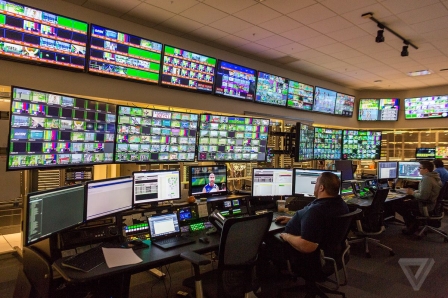How NBC Streamed The Rio Games
Here’s the tech NBC built to stream the Olympics — now can it replace TV?
The audience is moving to streaming faster than the money
For NBC, this year’s Olympic Games coverage was more than just a series of household rating points; it was a moment of truth in a fast-changing media world. To say the network won silver in prime-time television ratings would be kind: no matter which article you read, it points out that ratings were down by double digits at different points throughout the games. To say the network took home the gold in streaming video would also be an overstatement: online viewership was up, but the online experience wasn’t quite ready to replace the traditional TV experience.
That doesn’t mean the Olympics went unnoticed: Simone Manuel’s groundbreaking swim, Michael Phelps’ memeworthy game face, and Usain Bolt’s grin as he sprinted past his competitor all made it into national conversations. Katie Ledecky became a national hero, the next great American Olympian.
But for a multitude of possible reasons — anything from a late-summer start, tape delays, a multi-channel approach, or the notion that younger audiences might just have their heads stuck in a “Facebook bubble or a Snapchat bubble” as NBCUniversal chief Steve Burke actually predicted — fewer people wanted to watch those moments on regular television.
In short, a big shift is happening, one that NBC is acutely aware of now that the Olympics have passed. “We’re still learning and experimenting,” Mark Lazarus, chairman of NBC Sports Group, said in a phone interview with The Verge while the games were still in progress. “This is still a test across so many platforms, and we’re going to be learning some lessons that we’re going to be using in the future.”
That future isn’t in four years, though, that future is actually now. And at some point, what NBC streams online might have to be more important than what it broadcasts in prime time. This year’s Olympics were a demonstration that the technology works — now the trick is figuring out the best way to use it.

A control room in NBC Sports Group’s Stamford, CT headquarters.
NBC’s live-streaming video operations during the Rio Games were nothing short of an Olympic event in themselves. A giant map within the media center in Rio showed the multitude of video feeds coming in — all of which were shot by the Olympic Broadcasting Services, and then shared with media partners — as well as their route back to the nucleus of NBC’s sophisticated operations in the US.
As with a lot of endurance sports, the real training and preparation happens behind the scenes. In this case, it happens in a series of studios and control rooms inside what used to be a Clairol shampoo factory in Stamford, CT.


To support the staff in Rio, the NBC Sports Group ran a ground operation the size of a small college at the 300,000 square foot Stamford facility. The Sports Group’s headquarters typically holds a few hundred employees, but more than 1,100 people were on hand during the two weeks of the games — enough that the company had to put them up and shuttle them in from three different hotels.
Fiber connections from Rio to Stamford allowed NBC to produce event coverage remotely. An entire studio was packed with 13 vocal booths where producers, analysts, and color commentators watched video feeds from Brazil and announced events in real time for the streaming service — a cost-saving measure that cut down on the amount of talent and equipment NBC had to send to Rio. Staff in the Stamford control rooms were even able to control the lighting in the studios in Rio — another way of bringing employees to Connecticut instead of shipping them to another hemisphere.
“We’ve used almost every nook and cranny of this place,” said Kaare Numme, an NBC Sports producer who coordinated all of the at-home operations during the Olympics. He wasn’t exaggerating. Shortly after the Olympics started, when the building’s seven control rooms were already at capacity, the company borrowed an extra broadcast operations truck from Comcast Sports Philadelphia to help with the load. “For the first nine days this did all of the tennis coverage, from 9 in the morning till 10 at night,” Nuume said, pointing at the truck through an open hatch in the building’s loading docks.
When extra workers weren’t filling up control rooms, they sat at computers that lined the hallways. Another room, which the Stamford team dubbed the “highlights factory,” was full of about 40 workers whose sole purpose was to cut highlight videos specifically for the web. The other four studios in the building were at capacity, too — three were on the air during our tour of the building. On a more typical day, Nuume said, that number would never be more than one or two studios broadcasting at the same time.

For two weeks, Studio 4 in Stamford, CT was full of vocal booths that were used solely for remote announcing of live events in Rio.
All of this resulted in a stable, steady stream of online video — NBC actually streamed every minute of every Olympic event online, for the third year in a row — and notable gains in online activity. NBC says there were 100 million unique users across all digital platforms, a 29 percent jump up from the 2012 Olympics, though those are all online visits and not specific to video streaming. Fifty million people watched the Olympics video online, up 109 percent from years prior, and the total number of live video minutes streamed (2.71 billion) more than doubled the number from all prior games combined. This year, 42 percent of streaming video was watched on connected TVs and dedicated OTT devices like Apple TV.
Technically, the video streaming worked well. Dan Rayburn, executive vice president at StreamingMedia.com, tracked Olympics-specific complaints online and said the majority of them were “everyday life events” in the world of streaming media.
“Sometimes people have authentication issues, like you have to auth through Verizon and their page isn’t working. That’s not NBC,” Rayburn says, referring to the cable-authentication process NBC makes online viewers go through after 30 minutes of free Olympics watching. “There might be what we call frustration time — start up time, or buffering. That’s pretty standard. Sometimes web browsers are crashing mid-stream, but all of these browsers do things differently.”
The complaints appeared to be around the overall viewing experience online — not just pushing the digital video through pipes to people’s screens, but actually offering a satisfying delivery of the content.
One writer called the tape delays of live events, which ranged from a one-hour delay on East Coast streams to a four-hour delay out west, “absurd.” In the case of the London Olympics, the tape delays actually served the purpose of showing events during normal viewing hours for a US audience, but Rio is only one hour ahead of the East Coast time zone.
Watching the Olympics on the NBC Sports Apple TV app also wasn’t the best “lean-back” experience. During the games the app offered multiple viewing options for Olympics content. Options within the app offered “live” events, others marked “upcoming,” and more produced segments as well, like a Bob Costas-hosted package about the Ryan Lochte drama.
But some of the streams were raw feeds directly from the Olympic Broadcasting Service, which meant they lacked any branding or “live” bugs, while others were NBC-channel-produced. Navigating to an “upcoming” video might have brought you to a still image saying the event would begin shortly, even if it was in the middle of the night in Brazil. There was no channel guide, no Olympics schedule. On top of that, there wasn’t a PIP (picture-in-picture) option, so you couldn’t see what was going on in another window while you decided what to watch. Instead, users had to back out to the main menu of the NBC Sports app.

Each vocal booth used for remote announcing of Olympic events contained a screen for the play-by-play announcer, the color commentator, and a statistician.
Then there’s social media, which would normally seem ancillary to both TV and online streaming but has become a growing component of the sports landscape — Twitter is streaming entire NFL games this year, for example. NBC was active on Twitter, Facebook, and YouTube throughout the entirety of the Rio Games, and partnered with BuzzFeed to create content for Snapchat. But some clips seemed truncated, with quick cuts at key moments. Facebook and YouTube videos were capped at 45 seconds, with a slide at the end pointing viewers back to other means of watching the games on NBC. In essence, the footage that lived outside NBC’s paywalls was treated differently. This was true even on an internal level — to wit, clips cut by the “highlights factory” weren’t made immediately accessible to NBC Olympics social media teams.
There was almost a strategic imperfection to the approach and the message behind it was clear: if you really want to watch the Olympics, you should just watch it on real TV.
“TV is still the biggest platform for us, while streaming is an important part,” said Lazarus.
“TV is still the biggest platform for us”
Rick Cordella, NBC’s senior vice president and GM of the Sports Digital Group, echoed this in a separate interview, saying the network grapples with how much supplemental content to put out there online. Ultimately, he says, “The more content that is out there, making people more excited to tune in … if it’s people talking about Usain Bolt, then it drives more curiosity toward the prime time.”
In the short term this approach makes a lot of sense. NBC still wants people watching the Olympics on linear TV because that’s where the money is. Just 10 percent of NBC’s ad revenue during the Olympics came from digital. “Our CPM online is higher than the TV CPM,” Lazarus said. “But it’s just scale. The TV audience is just so much bigger, and I believe that will be the case for a long time. And marketers pay for scale. So money is still attributable to television for the foreseeable future.”
Second, advertising buyers are reportedly still pleased with the way NBC is handling ad plays, despite the lower-than-expected TV turnout. If that’s enough to entice them for upcoming Olympics, then that may be enough for NBC, which holds the rights the broadcast the 2020 Olympics and has paid the International Olympics Committee $7.75 billion for the rights to broadcast the Olympics in 2022 through 2032.
Rayburn doesn’t think over-the-top (OTT) video will ever be the primary source of video content for the Olympics. “No, the numbers will never work,” he said firmly. “How many subscribers do you have to sign up online just to make that up, a la carte? No matter how you run the numbers, it doesn’t work.”

That said, NBC is still doubling down on streaming, and is experimenting with other advanced technology to try to diversify its digital efforts. In May it said it would use all of its live-streaming technology to offer services to other media partners, branding it “Playmaker Media.” Basically, after years of streaming the Olympics, NBC has decided to turn its live-streaming operations, into a money-making opportunity when the Olympics and NFL games aren’t on. It’s a smart move, one that has proven successful for MLBAM, which began as Major League Baseball’s IT department and now has morphed into a market leader for end-to-end video-streaming services.
NBC executives wouldn’t divulge who its Playmaker Media partners are outside of the IOC, except to say there are a few handshake deals in place that would be revealed soon. It will be used by Telemundo to stream the Spanish-language US broadcast of the World Cup in 2018, as well as some NBC News election events in the near term.
“The technology is actually already there, so the work that we’ve done building up for this is a lot of the work that we’ve been doing building up for the NFL,” said Eric Black, vice president of technology at the NBC Sports Group. “It’s the same infrastructure.”
Lazarus also pointed out that the network is already streaming 4K video and testing virtual reality, although he isn’t especially bullish on either. A limited amount of the on-demand Olympics video was offered in 4K, but Lazarus said it’s still not cost-effective. “I think over time the 4K, the ultra HD, along with HDR, will be the format, but the cost to produce is not an efficient way to do it yet. The remote trucks and all that aren’t really built out for that,” he said.
And while his said his own experiences watching sports in VR have been positive — NBC has produced content for Nascar in VR as well as the Olympics — Lazarus said VR is still a “little wonky. It’s hard to watch TV with a welder’s mask on.”
So what do all of these technological advances mean for future Olympics — specifically, NBC’s coverage of future Olympics? It lost some of its grip on TV viewers during the Rio Games, but television viewership is still what it’s valuing the most. Its online viewership soared, but still can’t be monetized in the way that TV can. Social media is still “mostly marketing” at this point, according to Cordella — and yet other execs are adding weight to social media by suggesting it is siphoning away younger media consumers.
Trying everything at once and seeing what sticks, whether it’s online streaming, Snapchat stories, or “immersive” VR video, is hardly a new strategy in media. But if this year’s Olympics have shown anything, it’s that even if the sports revolution is televised, the people may not watch it — no matter how much you nudge them to do so.
If the sports revolution is televised, the people may not watch it
The Olympics have shown that second-screen content may no longer be just second screen, which means NBC would need to take a whole new approach to what that content actually is — not repackaged TV segments, 45-second snippets on YouTube, or delayed events, but something produced specifically for new platforms, and in a satisfying way.
“What role does social media really play? What is the impact of streaming head to head against our primetime or daytime telecast? What is the impact of programming up to five cable networks at once at the same time we’re on the main NBC broadcast? Whether those are good strategies, bad strategies, all remains to be seen,” Lazarus said. NBC has two more years to make those choices all over again before the 2018 Winter Games in Pyeongchang, and four more years before the 2020 Games in Tokyo. A lot can change between now and then, in terms of where people get their video; the biggest question of all is whether NBC will fully embrace that change.
Photography by Sean O’Kane
Disclosure: Comcast’s NBCUniversal is a minority investor in Vox Media, which owns this website.
(36)












